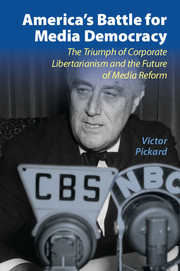 America's Battle for Media Democracy
America's Battle for Media Democracy Published online by Cambridge University Press: 05 October 2014
Despite its New Deal origins, the Federal Communications Commission (FCC) did not begin with a reformist agenda. The commission’s early years saw few policy challenges to American radio’s increasing commercialization. The inveterate media reformer Everett Parker, recalling how the FCC’s genesis was characterized by close ties to media corporations, quipped that prior to its formation, “four commissioners were vetted by AT&T and three by broadcasters.” Given such proclivities, the FCC would not seem to be a natural progressive ally. Although the 1934 Communications Act – the FCC’s founding charter and the blueprint for its regulatory power – gave it a mandate to serve the always-contested “public interest, convenience and necessity,” the commission was largely nonconfrontational in its interactions with commercial broadcasters. Indeed, what is known as “regulatory capture” – when federal agencies seemingly act in concert with the industries they purportedly regulate – gives a fairly accurate picture of how the FCC typically operates, then and now. However, under new leadership in the early 1940s, the FCC changed its behavior markedly. It confronted media corporations and aggressively defended public interest principles while facing considerable political opposition.
Few would have predicted such a turn. The FCC was preceded by the Federal Radio Commission (FRC), a temporary agency founded in 1927 to provide regulatory stability, particularly around technical issues, for the increasingly contested airwaves. Congress soon deemed the FRC inadequate to keep up with expanding communication technologies, and regulation of all interstate communications was consolidated under the new agency of the FCC, giving it authority over telephony and broadcast media. While its purview did not include potentially contentious duties like overseeing industry profits or rate structures, the FCC nonetheless faced several regulatory quandaries. As with the FRC, the FCC was tasked with granting licenses, inspecting equipment, and ensuring that broadcasting stations served a public interest mission. However, programming regulation was a thorny terrain because the FCC was forbidden by law to practice censorship as described in the Communications Act. Moreover, the standards by which licensees were judged remained ill defined, thereby inviting charges of arbitrariness. Thus any FCC attempt to establish public interest standards invited conflict with the commercial broadcast industry, including accusations of paternalism and infringement of free speech. These power struggles often hinged on the question of government’s role in media regulation and disagreements over First Amendment interpretations.
To save this book to your Kindle, first ensure [email protected] is added to your Approved Personal Document E-mail List under your Personal Document Settings on the Manage Your Content and Devices page of your Amazon account. Then enter the ‘name’ part of your Kindle email address below. Find out more about saving to your Kindle.
Note you can select to save to either the @free.kindle.com or @kindle.com variations. ‘@free.kindle.com’ emails are free but can only be saved to your device when it is connected to wi-fi. ‘@kindle.com’ emails can be delivered even when you are not connected to wi-fi, but note that service fees apply.
Find out more about the Kindle Personal Document Service.
To save content items to your account, please confirm that you agree to abide by our usage policies. If this is the first time you use this feature, you will be asked to authorise Cambridge Core to connect with your account. Find out more about saving content to Dropbox.
To save content items to your account, please confirm that you agree to abide by our usage policies. If this is the first time you use this feature, you will be asked to authorise Cambridge Core to connect with your account. Find out more about saving content to Google Drive.